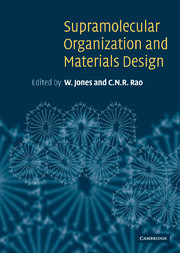Book contents
- Frontmatter
- Contents
- List of contributors
- Preface
- 1 Assembly and mineralization processes in biomineralization: strategies for forming biological composite materials
- 2 Mesoscale materials synthesis and beyond
- 3 Towards the rational design of zeolite frameworks
- 4 Mesoscale self-assembly: the assembly of micron-and millimeter-sized objects using capillary forces
- 5 Design of amphiphiles for the modulation of catalytic, membranous and gelation properties
- 6 Nanofabrication by the surface sol-gel process and molecular imprinting
- 7 The hierarchy of open-framework structures in metal phosphates and oxalates
- 8 Mesoscale self-assembly of metal nanocrystals into ordered arrays and giant clusters
- 9 Layered double hydroxides as templates for the formation of supramolecular structures
- 10 Molecular machines
- 11 Some aspects of supramolecular design of organic materials
- 12 Controlling crystal architecure in molecular solids: the supramolecular approach
- Index
3 - Towards the rational design of zeolite frameworks
Published online by Cambridge University Press: 18 December 2009
- Frontmatter
- Contents
- List of contributors
- Preface
- 1 Assembly and mineralization processes in biomineralization: strategies for forming biological composite materials
- 2 Mesoscale materials synthesis and beyond
- 3 Towards the rational design of zeolite frameworks
- 4 Mesoscale self-assembly: the assembly of micron-and millimeter-sized objects using capillary forces
- 5 Design of amphiphiles for the modulation of catalytic, membranous and gelation properties
- 6 Nanofabrication by the surface sol-gel process and molecular imprinting
- 7 The hierarchy of open-framework structures in metal phosphates and oxalates
- 8 Mesoscale self-assembly of metal nanocrystals into ordered arrays and giant clusters
- 9 Layered double hydroxides as templates for the formation of supramolecular structures
- 10 Molecular machines
- 11 Some aspects of supramolecular design of organic materials
- 12 Controlling crystal architecure in molecular solids: the supramolecular approach
- Index
Summary
Introduction
Zeolites are crystalline, microporous materials composed of oxide tetrahedra of silicon and aluminum that are three-dimensionally connected to give an O/[Si + Al] = 2. Each Al+3 in the oxide framework requires an extra-framework charge-balancing cation to maintain electroneutrality of the material. The charge-balancing cations for as-synthesized zeolites can be inorganic, organic or organometallic and can be post-synthetically changed to industrially useful cations such as protons and transition metals.
In addition to aluminosilicates, crystalline microporous materials can be phosphate-based. The aluminophosphate (AlPO4) framework is electroneutral (analogue of SiO2), and the aluminum and/or phosphorus tetrahedral atoms can be substituted by a number of metal and non-metal atoms that result in producing charged frameworks [1–3], e.g. Si+4 substitution for P+5. In addition, numerous other metal oxide, and nitride based microporous materials have been reported recently [4, 5].
To date, approximately 125 different microporous structures have been reported to the International Zeolite Commission (IZC) for structure codes [6] and the interested reader can access this information via the following website: http://www.iza-structure.org. Each microporous material is assigned a threeletter code by the IZC (the IZC code will be used throughout the remainder of this chapter). These microporous materials are distinguished by the connectivity of the framework atoms that determine the size and dimensionality of the pores and/or cages that they possess.
- Type
- Chapter
- Information
- Supramolecular Organization and Materials Design , pp. 83 - 102Publisher: Cambridge University PressPrint publication year: 2001

